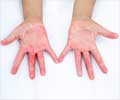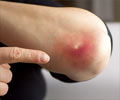Washing hands can reduce a wide range of hospital-related infections. However, the National handwashing campaign reduces the incidence of Staphylococcus aureus infection in Australia's hospitals.

‘Poor hand hygiene increases the risk of developing a wide range of hospital-related infections. However, the National Hand Hygiene Initiative (NHHI) implemented in Australian hospitals successfully reduced the incidence of Staphylococcus aureus infections.’
Read More..




For every 10 percent increase in hand hygiene compliance, there was an associated 15 percent decline in the incidence of S. aureus bloodstream infection in Australia's 132 largest public hospitals, which provide over three-quarters of all public inpatient care (over 15 million patients-days nationally in 2016-17).Read More..
The results were achieved by promoting WHO's '5 Moments for Hand Hygiene' to reduce the risk of healthcare-associated infection--before touching a patient; before a clean procedure; after exposure to body fluids/wounds; after touching a patient; and after touching a patient's surroundings.
The national culture-change programme could be a template for similar initiatives in other countries, researchers say.
"Hospital-acquired infections are a major concern for hospitals around the world and S. aureus is among the most dangerous," says Professor Lindsay Grayson from Hand Hygiene Australia who led the research. "The risks to patients are enormous, as are the associated hospital costs. Despite robust evidence supporting improved practices for hand hygiene, securing compliance is notoriously difficult, and few national programmes have been sustained in the long-term."
S. aureus is the leading Gram-positive bacterium responsible for hospital-acquired infections including endocarditis, acute pneumonia, and sepsis. S. aureus infections are linked to poor hand hygiene compliance.
Advertisement
The analysis found a significant improvement in hand hygiene compliance in hospitals nationally--from 64 percent (36,213 of 56,978) of potential hand hygiene opportunities (Moments) in 2009 to 84 percent (494,673 of 586,559) in 2017.
Advertisement
Among Australia's 132 major public hospitals, improvements in hand hygiene compliance were associated with declines in the incidence of S. aureus infection--with every 10 percent increase in hand hygiene compliance, the incidence of S. aureus infection declined by 15 percent. Overall, average rates of S. aureus infection fell from 1.27 new cases per 10,000 bed-days in 2010-11 to 0.87 per 10,000 bed-days in 2016-17.
The research team points out that a negative correlation between annual change in hand hygiene compliance and annual change in S. aureus infection at the hospital level (especially for the largest hospitals), suggests that declines in S. aureus infection were not simply time-dependent, but were more likely associated with changes in hand hygiene compliance.
"The National Australian Hand Hygiene Initiative has achieved impressive results, both in terms of improving healthcare worker hand hygiene compliance and its association with reduced rates of healthcare-associated staphylococcal bacteraemia. Few national programmes have become successfully integrated into national health-care structures", says Professor Grayson.
The authors note several limitations including that hand hygiene compliance reported in the NHHI is likely to be better than average real-world compliance since some of the auditing was done during evening or night shifts or on weekends, and healthcare workers are far more likely to comply with hand hygiene guidelines when they know they are being watched. Whilst auditors were trained to accurately record hand hygiene compliance in a busy clinical setting, the authors cannot be sure that all 'Moments' were captured. Finally, they note that while a strong link between improved hand hygiene compliance and declining incidence of S. aureus infection was found, other factors such as viral respiratory outbreaks or antimicrobial stewardship programmes may have had some impact.
Source-Eurekalert












